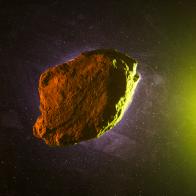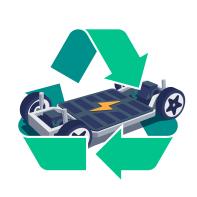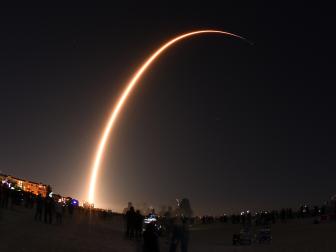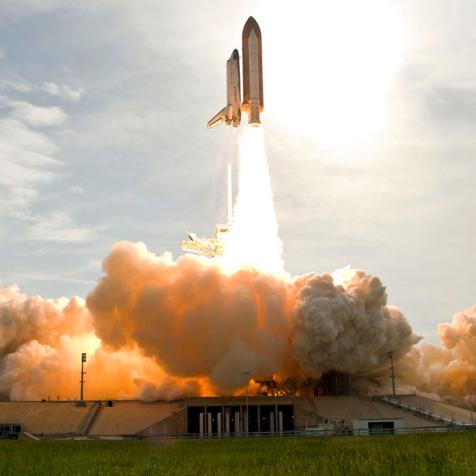
NASA/SpaceX
It's Time for a 2021 Space Flight Round-up

Space is a busy place, with a lot of things going up (most of the time) and coming down (when we want them to). Let’s check in on the latest orbital happenings.
Virgin Galactic
Billionaire Richard Branson’s Virgin Galactic, the spaceflight company that has not conquered the whole “spaceflight” thing just yet, announced the next in line of its fleet: The SpaceShip III Imagine. Imagine doesn’t look much different than its SpaceShip II predecessors, except for the claims by Virgin Galactic that it’s easier to manufacture multiple copies of it. This is supposed to help them reach their goal of 400 suborbital (which means you go up and come down without orbiting the Earth) flights every year. That would be a big step up from its current capacity of their current zero flights per year.
More About Virgin Galactic
Out of This World! Inside Virgin Galactic's Spacecraft
Buckle up! On July 28, Virgin Galactic is showing the world what the inside of their SpaceShipTwo Unity spacecraft looks like via a livestream on their YouTube channel.
Virgin Galactic Failed to Launch because Space is Hard
This is the first test launch from Branson’s Virgin Galactic company since February of 2019, and follows a string of delays, cancellations, and aborts. What’s going on?
SpaceX
What goes up must come down, which SpaceX is learning again and again as it tries to work out the bugs in its newest rocket, the Starship. Elon Musk and team hope that the Starship will be powerful enough to send crews to Mars. Since bugs on a rocket can lead to potential catastrophe, it’s a good thing that they’re testing Starship without anyone on board.
The difficult thing about Starship isn’t the launch itself — which by now for SpaceX is a piece of cake, but the landing. Starship is supposed to be reusable, returning to land safely on the Earth after delivering its cargo beyond the confines of Earth’s gravity. But in order to make it work on such a massive craft before it lands, it has to flip itself from horizontal to vertical right before landing which has proven to be difficult. The last attempt, on March 30, failed because of a methane leak in one of the engines.
More About SpaceX
SpaceX vs. the Universe
Fans of space are having a tough time picking sides over a recent controversy between SpaceX and astronomers. But what's the big debate all about? Astrophysicist Paul M. Sutter digs into both perspectives.
SpaceX Test Flight Ends in Explosion
An experimental rocket launched by SpaceX on Wednesday, December 9 exploded after launching 8 miles into the air. Elon Musk says that this test was still a success.
NASA
It's a good thing that NASA didn't contract to use the Starship yet, and instead stuck to the tried-and-true Falcon 9 for its April 23rd launch of a crew to the International Space Station. This was the second crew launch with SpaceX, following last summer’s historic use of a private company for delivery of humans to the station. Those folks will be hitching a ride back home on a SpaceX capsule and the splashdown is currently scheduled for Sunday, May 2 around 2:53A ET.
In robotic explorer news, “Percy”, the adorable nickname for NASA’s Perseverance rover on Mars, has begun taking data after a successful (if scary) landing on the red planet. As an added bonus, Percy’s little friend, Ingenuity, recently detached from the rover and settled on the surface. Ingenuity is a drone aircraft specifically designed to work in the thin Martian atmosphere, and will begin its first test flight soon. If successful, it will be the first powered flight on another world in the history of humanity. The Wright brothers would be proud.
More About NASA
Journey to the ISS: NASA and SpaceX Crew-1 Mission 14 Photos
(Updated: November 17, 2020) From launch preparation on land to docking with the ISS in space, here are some highlights from the NASA and SpaceX Crew-1 mission. NASA astronauts Michael Hopkins, Shannon Walker, and Victor Glover, along with Soichi Noguchi of the Japan Aerospace Exploration Agency launched in a new Crew Dragon spacecraft atop a Falcon 9 rocket on November 15 at 7:27P ET from the NASA Kennedy Launch Complex 39A. After a 27 hour journey, the spacecraft docked with the ISS at 11:01P ET.
Journey to the ISS: NASA and SpaceX Crew-2 Mission 22 Photos
From launch preparation to docking with the International Space Station, here are some highlights from the NASA and SpaceX Crew-2 mission. NASA astronaut Shane Kimbrough, NASA astronaut Megan McArthur, ESA astronaut Thomas Pesquent, and JAXA astronaut Akihiko Hoshide are scheduled for liftoff in a Crew Dragon spacecraft atop a Falcon 9 rocket on April 23 at 5:49A ET from the NASA Kennedy Launch Complex 39A. After a 23-hour journey, Crew-2 will then dock with the International Space Station on April 24 at 5:10A ET.
Ingenuity Takes First Flight on Mars
In a historic first, Ingenuity successfully flew on the Red Planet. The Mars helicopter was in the air for about 40 seconds.





















































































